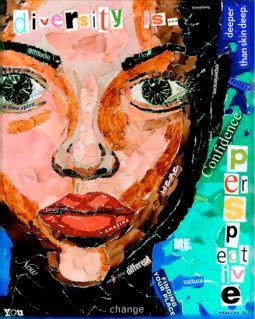
- Below are links to videos of the event -
http://s136.photobucket.com/albums/q170/mariananghela/?action=view¤t=IMG_1286.flv
http://s136.photobucket.com/albums/q170/mariananghela/?action=view¤t=IMG_1292.flv
http://s136.photobucket.com/albums/q170/mariananghela/?action=view¤t=IMG_1289.flv
http://www.facebook.com/video/video.php?v=1414322400739




Wednesday, May 5, 2010
*A SONG OF HOPE FOR CHILI - DIVERSITY EVENT
Posted by Maria at 7:41 AM 7 comments
Saturday, April 24, 2010
Prompt # 6 - SHOR
The culturally competent teacher communicates in ways that demonstrate sensitivity to sociocultural and linguistic differences, using a variety of verbal and non-verbal communication techniques that encourage positive social interaction and support learning in their classroom. How have you (or the classroom teacher) communicated in ways that demonstrate sensitivity and responsiveness to sociocultural and linguistic differences?
As I have said before, good behavior is valued in this classroom. Therefore, there must be some sort of connection between the teacher and the students to establish this behavior. There is a chart in the classroom with all the children’s names. Above the names is a green slip of paper. With each bad behavior (talking out, talking back, not listening) the child goes to the chart and switches their color (green to yellow, yellow to red). This encourages positive interactions in the classroom. If the children are behaving, and have a sense of discipline, this will encourage them to behave and therefore the classroom will run smoothly. If this was not happening, and the children visually did not see this colored chart, they couldn’t have a sense of discipline and therefore, would misbehave more frequently.
English professor Ira Shor believed in a problem-posing, critical, pedagogy. Critical pedagogy means questioning the way things are. In traditional schooling, the classroom is teacher-centered, and therefore, the teacher is in power. In a student-centered classroom, the students and teachers work together. This leads to individual growth, cooperation, and togetherness. Participation is the most important part of schooling. Children learn through interaction and experimenting. By giving children the opportunity to participate, allows them to be curious, and this is crucial to democracy. Therefore, democracy and participation go hand in hand. Endullment, or the lack of participation, lessens the child's opportunity to individual success.
Young children are visual and hands-on learners. Engaging the children in a lesson where they can participate with their peers and with the teacher is crucial. That is why, when Mrs. Berna introduced me to a game using their vocabulary words, I continued to play the game each week. Repetition is also the key to success at a young age. The more children see or do something, the more confident they become at it each time. There were two vocabulary word games that I used each week when I tutored my four students. One was a matching/puzzle-type game, and the other was a game, which evolved rolling a large cube. Game number one simply evolves flash cards of high frequency Spanish vocabulary words, cut in half. We spread all the slips of paper on the table. The children take turns finding 2 slips of paper to form a familiar word. The children like to do this and they all help each other. Once all the matches are made, each child reads off all of the words they have made! The second game is corporative and repetitive. Two large 6-sided cubes have 6 different words on them. The two cubes are identical. The children form groups of two. They take turns rolling the dice. They must read and tally which word they get by writing it on a worksheet. The game finishes when both groups have completed their tally charts. The children like this game because they get to work with a partner and get a little competitive!
Posted by Maria at 11:37 AM 1 comments
Prompt #2 - KOZOL
Describe the linguistic, ethnic, and sociocultural characteristics of the students in the classroom in which you are tutoring (Use the data on Infoworks as well your observations). What cultural capital do the children bring into the classroom? What assets can be developed that will strengthen our society/democracy?
First of all, I would like to say that every article I have read in this class have helped me understand the classroom I tutor in. If I were put in this classroom without prior knowledge to ELLs, the transfer method, and so on, I would have many unanswered questions. Every child in this classroom is an ELL. Every child's primary language is Spanish. This ethnic equality between all the children and their teacher forms a bond and ties them together. Although they all speak good Spanish, their levels in English vary.
I have witnessed various activities when some children succeed while others try to hide and not be picked on. For example, there is a word wall in the front of the class. When ever Mrs. Berna is doing something else and a group of children need to be given something to do in the mean time, she hand out her pointer to one child. That child must point to a word and recite it to the class while all fellow classmates repeat after her. Some children are louder than others, and some, simply have no idea what is going on. Therefore, there still is a gap between the intellectuals of these ELLS.
I am very happy to have been introduced to the info-works website. I used it once before for my mid-term project. That time, I compared the results of 2 schools, only 10 minutes away from each other, but in very different neighborhoods. School number 1 was the elementary school I attended as a child, and school number 2 was the school i tutor in now. I created a venn diagram, and almost every piece of information was the complete opposite. I am know looking at the results on info-works for this school again, and 100% of English Language Learners are not proficient in reading or math. That means that every single one of the children I have met with for 15 hours during this year, is not proficient. Clearly something needs to be done about this. The reason why these innocent children aren't proficient is because the same tests given to them are the tests given to children whose primary language is in English!!!! By knowing this, it makes me feel very happy and proud to have gotten to help these children with their reading skills. I wish I could have also tutored them in math. If I had more free time and I would have known these statistics when I first started, that would have been a very big motivation for me to work my hardest with the children and spend a few more hours a week there.
Another very important thing that the info-works website told me was that Hispanic and African American children made up the largest population of the school. According to the charts, there were fewer than 10 schildren that belonged to each of these backgrounds: White, NAtive American, and Asian. Just by walking through the hallways, I could have told you this. To tell you the truth, my whole 15 hours there, I did not see one Asian child or Native American child. I did see about 2 white children, but no more than that. These statistics lead me to my connection to Jonathan Kozol.
Jonathan Kozol, an educator, activist, and writer, belived that segregation in all schools still exist. JOnathan kozol could use the chart on inforworks in his article and it would fit in perfectly. An ethnography is an example of qualitative research, and this is what Jonothan Kozol did. He was immerced in everyday activities as opposed to lab-based reseach. Kozol went to various schools in different areas. Kozol states, "Even these statistics, as stark as they are, cannot begin to convey how deeply isolated children in the poorest and most segregated sections of these cities have become." In most of the schools that Kozol visits, Hispanics and African Amricans represents the bulk of the population. In one of the schools, one of the teachers who have worked at the school for 18 years said that she has only taught one white student. This relates to my experience, which I talked about above.
IN conclusion, the school I tutored in would be a great example for Kozol to add to his article. It fits in with his statistics of schools in poorer neighborhoods. These students miss our on opportunities. Some of the schools Kozol talked about did not even have school nurses, or nice land, or music or art classes. Kozol was one of my favorite articles because it opened my eyes. Segregation does still exist and every future teacher must be aware of these eye-opening statistics and facts. We must open our eyes and help the children of the future.
Important Links*
http://www.infoworks.ride.uri.edu/2009/pdf/achievement/28134E-achi.pdf
Posted by Maria at 11:36 AM 0 comments
Sunday, April 11, 2010
Prompt #5 - DELPIT
Imagine that you are the teacher of this classroom. What challenges might you encounter in collaborating with the parents of your students? How might you address these challenges? How might you demonstrate respect for the concerns or contributions of parents?
As the teacher of this classroom, I would need to come up with a way to communicate with parents. The classroom that I tutor in is a bilingual classroom. All of the children are English Language Learners, and all the children come from a Hispanic background. Therefore, I will need to communicate with the parents or guardians of my students in Spanish. Since I also come from a Hispanic background (my mom is Hispanic and my father is Italian), I believe that the parents will feel comfortable in communicating with me.
Communication is key in a classroom, as well as the work place, and anywhere in society. Without communication, what will hold things together? Without parent-to-teacher communication, a classroom will not run as smoothly. As a teacher, you must learn about your students’ personal life, to a certain extent, that is.
If I were the teacher in this classroom, I would demonstrate respect the concerns and contributions of the parents by having a "Parent Appreciation Week". During the week, the children will create books, letters, and songs especially for their parents. A new project or assignment done by the child to honor the parent will be sent home every afternoon for the parents. All of this will lead up to a special "Parent Appreciation Party" on Friday afternoon. All the parents would be invited to come to the cafeteria from 3:30-5:30 pm where I will have provided refreshments, tables, and student work displayed. During this time, the parents will have an opportunity to talk to one another and talk to me as well. I think that having this special time will make the parents feel even more comfortable and able to talk to me about anything throughout the course of the year. This time would also break that barrier of the teacher having more power over the parent. The parents’ voices, as well as their children’s voices, are just as important.
Theorist Lisa Delpit believed that a silenced dialog exists between white teachers and African American teachers. This can also be true parents and teachers. As a minority parent, they may feel much under the head teacher in classroom and therefore will be shy and not talk to the teacher. As a teacher in a classroom, you must break that tense border between you and the parents of your students.
Lisa Delpit also stated that the cultures between black and white educators do not match. Because of this, they will rarely be on the same page about decisions. The same thing is true between parents and teacher relationships. In this classroom, though, we would all be on the same page. Given that I connect on a personal level with each and every parent, they will feel more comfortable and level with me.
In The SIlenced Dialog, Delpit said that we must not teach as if English is more superior to the other language (in this case, Spanish). In doing this, you are inadvertently saying that you, the English speaker, is more superior to the Spanish speaking person. In my bilingual classroom, I would treat both languages with equal importance!
Posted by Maria at 1:48 PM 2 comments
Prompt #4 - CARLSON
How might your personal history/sociocultural characteristics intersect with those of your students? What challenges or advantages might you have as a teacher in this classroom? What misconceptions about various cultural groups have you confronted during this experience? 
My strongest belief has always been that that your environment and the way you were raised have the biggest impact on your views. Since no two people share the same pair of eyes, we all have our own bias and our own opinions. As stated by Lisa Delpit, "No one speaks from everywhere and no one speaks from everywhere."
If I were the teacher in this classroom, I would face both advantages and challenges. Coming from a Hispanic background, I can culturally connect with the students. Some days while I am observing the behavior and actions of the students, I can make a comparison to a child in my life with no problem, whether it be a cousin or a friend. This, I believe, would allow me to be more compassionate and forgiving with the child. As opposed to a teacher who is not culturally competent, who would not be able to make these personal connections and would therefore feel the complete opposite towards the child.
One of the biggest challenges which I am currently facing would be the language. Although I speak Spanish at home and I am exposed to at family gatherings, I have never taken a Spanish class at school. This enables me to be totally confident and comfortable speaking to the teacher or to the children. Most of the children there speak Spanish more properly than I do! (I get a kick out of this). Needless to say, I am a little quieter than I am when I am in a the classroom who’s main language is English. Although I do not feel completely comfortable having an educational conversation with Mrs. Berna in Spanish, when speaking with the children and doing a lesson with them, it is a little easier and I can throw in some English words. I have so far taught them a few phrases such as, "no peaking" and "thumbs up", during our lessons. The children love using these phrases and one little boy, Johnny, even told me that he told him mother about his new phrase, "no peaking". The children think it is funny when I say something in English but at the same time they are very eager to learn new words!
Although I work at a preschool where about 90% of the children are White, I was not faced with any misconceptions of cultural backgrounds while being in this classroom. As I said before, I am from a Hispanic and White background and therefore I am aware of the cultural differences. Although I was not faced with any, this doesn’t mean no one else was. Stereotypes are very strong and do exist.
Theorist Carlson said that we must challenge essentialist worldviews. Carlson said there are six ways in which we are primarily different. They are biologically fixed in our body and cannot be changed. These ways are, age, race, gender, physical attributes, ethnicity, and sexual orientation. These biological characteristics make us who we are, but it doesn’t stop there. There are also secondary differences, such as our beliefs, hair color, religion, career, and class. As a society, we cannot judge a person, or child, only because of one of these characteristics. We must rupture borders and realize that everyone is a complex person.
Posted by Maria at 1:38 PM 1 comments
Prompt #3 - GOLDENBERG
The culturally competent teacher should be able to use a variety of assessment techniques appropriate to diverse learners and accommodate sociocultural differences that affect learning. How might the teacher be responsive to the linguistic, ethnic, and sociocultural characteristics of the students in his or her assessment practices?
After doing some observing and tutoring in Mrs. Berna’s bilingual Kindergarten classroom, I have taken note of some techniques that prove that she is culturally competent. For one, she has a specific way of how the children write and learn their words, and I am in charge of doing this writing exercise with four children every Wednesday morning. The assignment is writing three short words seven times each. The words are in Spanish, of course. During my second visit, I was given a list of all the words the children need to practice. Each week I carefully choose 3 of the words to work with. I have my own technique of choosing the words. I usually choose by length, and I am careful not to pick all four- letter words in one day. First of all, I think it is too much writing in one sitting anyway, so I may choose one 4 letter word, one 3 letter word, and one 2 letter word. I also pay close attention to the order I teach the words. I do the longest word first because they have the more focus right at the beginning of the lesson. And I do the shortest word last because by then they are antsy and just want to be done with writing.
I will now describe the special method that Mrs. Berna has told me to use. First, I hold up the site word and we read it. Next, I show one letter at a time while covering the rest and together we do the sound of the letter. Next, I cover the entire word and the children must write it down from memory. When all 4 of the children are done, we revise. I hold the word up again and the children are allowed to correct any mistakes they have made. Finally, they must fold their paper to cover the word they have previously written and start the process all over again until the row is done and then continue the same method with the next words.
I will connect this experience with Claude Goldenberg. Goldenberg was a believer in transfer. Once proficient in your primary language, it be easier to learn the same information in English. Many words and letter sounds in Spanish, for example, are similar to English. Goldenberg uses the example of the word “elefante” which translated to “elephant” in English (15). If children learn to recognize and read and write these words in Spanish, they will begin to recognize, read, and write these words in English.
Mrs. Bernas bilingual kindergarten classroom is a great example of Goldenberg’s theory. All the children in the class speak Spanish. At this very young age, if they were placed in English speaking classrooms, they would not succeed. They would not be able to confidently communicate with their classmates or their teachers and therefore, would not build communication skills.
At first, I was a bit puzzled as to what would happen in first grade, when these kindergartners had to move up? Would they be placed in a non-bilingual classroom? This thought stuck with me for a few visits until I asked Dr. August. All she had to say was, "What did Goldenberg say?", and it immediately clicked. Although the children are learning everything in Spanish, there are many times I have witnessed then going over things in English as well, such as the months of the year.
We have all heard of "high frequency" kindergarten words. These are important site words that the children should learn. The "high frequency" in this classroom is the same as in an English speaking classroom, except they are in Spanish. These are the words that I am in charge of teaching my group, and thanks to Goldenberg, I understand the concept of transferring their skills. Once they learn the "high frequency" words in Spanish, they will learn them quicker in English. I am very thankful that I was placed in this bilgual classroom. It has opened my eyes and made me wore aware. We as teachers need to help these children learn. These children are the future and they need us so that they will succeed in life. If they are not taught early on, chances are they will get by throughout schooling and never learn proper English. More classrooms like this one need to exist across the country.
Posted by Maria at 7:45 AM 1 comments
Prompt #1
1. Describe the neighborhood, school building and classroom in which you are volunteering. What do you notice about the space and structure of the school? How do people use the space? How does this school “feel” to you? What contributes to this feeling? Describe the classroom, the teacher, and the students. What is valued in this school? In this classroom? How can you tell? 
As I first turned right onto Caban Street where High Mountain Elementary School was located, I was feeling nervous and uneasy. The first thing I noticed was that there was a large parking lot right across the street from the school, which came equip with a cross walk that led to the school itself, connecting the two like a puzzle. I carefully parked my car, being sure to lock the doors, of course, and ran across the crosswalk tightly grasping my umbrella. I rang the doorbell, tiny compared to the large white brick building it was mounted on, and patiently waiting for the door to unlock.
Inside this unfamiliar place, I was greeted by stairs which took me to a set of double doors. I walked in and saw children sitting on the floor still wearing jackets and backpacks. There were two teachers standing around having a conversation, and another turning the TV on for the children. Since it was a rainy day, I assumed, they got to watch some TV before the school bell rang. I felt like a stranger walking into someone’s home, as all the children, and staff watched me fiddle with my umbrella and look for some type of sign that said office. One woman noticed I looked confused, and asked me if I was a sub. I kindly told her who I was and what I was looking for. She was really nice, and guided me to the office. I responded to her in Spanish because I knew that was her primary language although she addressed me in English. I thanked her and strolled into the office.
I introduced myself one again, to the secretary who seemed annoyed by something. She showed me where the VIPs binder and left the rest for me to figure out. After signing in, I looked up and noticed student art all over the walls of the office. This made me smile. I did not bother to ask the secretary where room 3 was, and I walked back out into the loud corridor. After walking through the maze of children, I spotted room numbers 7, 8, 9, 10, 12, and 13 but no number 3. "Great" I thought. That must have shown on my face when the same nice lady who guided me to the office approached me. She asked me what room I was looking for and told me to go down the stairs and take a left. I kindly thanked her again and was on my way down the wet white stairs.
Downstairs was much quieter. I quickly found room #3. The double doors were shut, so I peeked in through the small window. My eyes were greeted with book, pictures, two lonely (and cluttered) teacher desks, small tables for the children, a door that was open a crack (which I came to find out was a bathroom) and 5 windows high up which were led to by a set of stairs that looked like a fire escape. I was a little early so I leaned back on the wall and waited to meet the class, and the teacher. As I waited I tried to give the name Mrs. Borna a face and a body. Was she young or old? Tall or short? Nice or not so nice? My thoughts were quickly interrupted by a swarm of children coming down the stairs behind me. I was kindly greeted by the bilingual classroom I had been waiting to meet and sweet Mrs. Borna who now had a face and a body.
Within the first 10 minutes in the classroom I could tell that what was valued in the classroom is the following: organization, attendance, structure, and site words. In the school, however, I believe that safety and organization was valued. To me, the school as a whole feels welcoming and homey. Everyone knows each other and all the people I came across have a friendly face, except for the secretary which I found out was only in for the day.
Posted by Maria at 6:43 AM 0 comments
